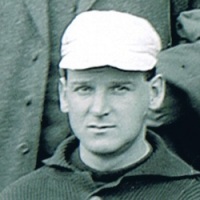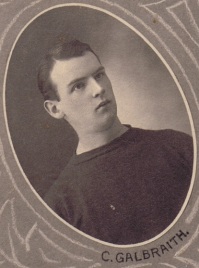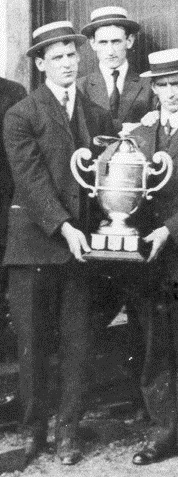
CHARLES (CHARLIE) H. ‘SMILER’ McCUAIG
(born ca. 1887 – deceased)
Vancouver Athletic Club (1907; 1910-1913)
Mount Pleasant Maple Leafs (1908-1909)
Vancouver Athletics (1914)
Vancouver Lacrosse Club (1915; 1921)
Vancouver ‘Greenshirts’ (1918)
Vancouver Terminals (1919; 1922)
Long Beach (1924)
One of the many now-forgotten Vancouver lacrosse players who plied their trade in the post-Great War professional game, Charlie ‘Smiler’ McCuaig played in 55 games over 7 seasons with an assortment of Vancouver teams in the British Columbia Lacrosse Association, Mainland Lacrosse Association, and Pacific Coast Lacrosse Association. He was born in Boissevain, Manitoba, located on the Canadian border with North Dakota, around 1887.
Prior to turning professional, he played at the senior amateur level for the Mann Cup champion Vancouver Athletic Club for three seasons from 1910 through to 1912. McCuaig seems to be have been absent from the 1913 Mann Cup team (or at least absent from the club’s portrait-collage photograph commemorating their three Mann Cup titles) even though he was a member of the squad that challenged the New Westminster Salmonbellies for the professional Minto Cup in 1913. Prior to his time with the VAC dynasty team, he had actually debuted with the VAC intermediate team in 1907 and then played two seasons of intermediate lacrosse with the Mount Pleasant Maple Leafs in 1908 and 1909.
He was a defensive midfielder who could also cover the coverpoint and point defensive positions when required. He scored 5 goals and had 12 penalties for 77 penalty minutes to his name. There is not much press about Charlie McCuaig, except about getting beaten flatfooted by speedster ‘Pat’ Feeney in one match in the early-1920s. Another article, from May 1915 in the Vancouver Daily World, mentioned that McCuaig and fellow teammate Everett McLaren were in Kansas City and on their way back to re-join the Vancouver team for the 1915 season – their business for being in Kansas City is completely unknown. McCuaig would return to Kansas City for further employment 1920.
In the last week of October 1918, various national newspapers such as the Ottawa Citizen, Montreal Gazette, and Victoria Daily Colonist reprinted a story out of Vancouver that he was “critically ill with double pneumonia and not expected to survive”. Whether such sensationalism was warranted or not is unknown, but McCuaig had recovered in time to be included on the first roster drafted by the new Vancouver Terminals outfit organised on May 19, 1919.

Charlie McCuaig was replaced by former Vancouver Athletic Club team-mate Eustace Gillanders in 1920 when unknown work “making good money way down in Kansas City” with a “good position there” made him reluctant to return to Vancouver for the season. Later that year he then found himself in Colorado with another lucrative job there.
He returned the following year to play for Con Jones’s Vancouver entry in his brand-new Pacific Coast Lacrosse Association. When the PCLA folded a month or so later after 5 games played in its schedule, McCuaig found himself sitting on the sidelines.
McCuaig was picked up by the Vancouver Terminals for the 1922 season when defensive spots opened up with the retirement of the legendary Johnny Howard and the departure of Eastern import D. Langevin. By the following season, Everett McLaren had been moved back to his comfortable place at coverpoint after a one-season sojourn spent playing in the midfield and ‘Smiler’ McCuaig departed the professional scene for good.
Charlie McCuaig appeared in a team photo for a match played in California with the Long Beach team on March 30, 1924. Former New Westminster star Tom Rennie was also a member of the Long Beach squad which faced the California Canadian team from Los Angeles.
What Charlie McCuaig did when his lacrosse days were over, as well as when he passed away, is unknown – however a July 1953 article printed in the Vancouver Sun mentions that one of the old trainers for the Vancouver Athletic Club, Billy Grant, had met up with ‘Smiler’ while visiting Los Angeles.
(PHOTO SOURCES: CVA 99-1019 excerpt; CLHOF collection)





You must be logged in to post a comment.